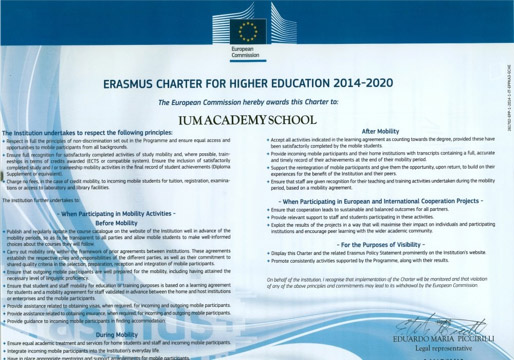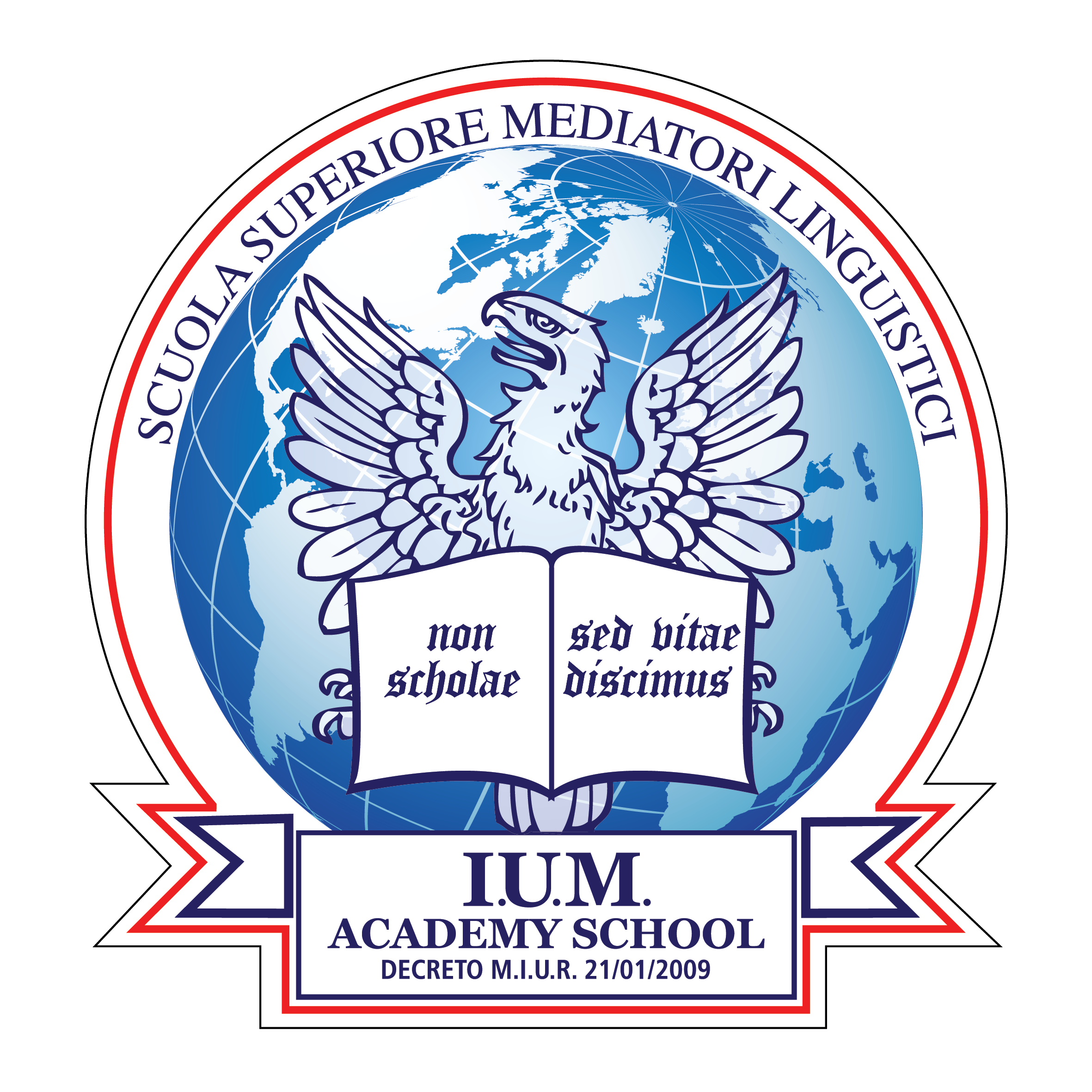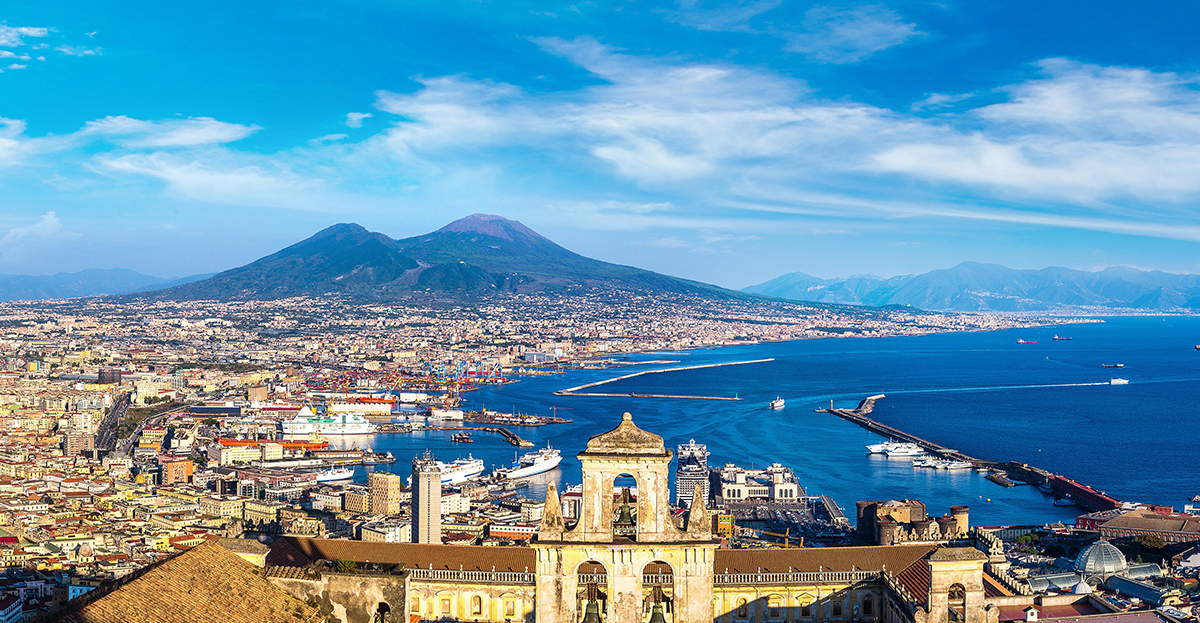Erasmus Charter For Higher Education 2014/2020
Scuola Superiore Mediatori Linguistici di Napoli

Erasmus Charter For Higher Education 2021/2027
Scuola Superiore Mediatori Linguistici di Napoli


SCUOLA SUPERIORE MEDIATORI LINGUISTICI DI NAPOLI
The IUM Academy School has identified the process of internationalization as the tool and the primary objective of the qualification of its training and research activities, formulating “a system” of measures that can facilitate the consolidation and consistency of the flow of students and teachers outgoing and incoming.
In the framework of the Bologna process, this means:
commitment to the development teacher and student mobility at all levels of study;
promoting the international dimension of curricula studiorum through the analysis of the feasibility of joint courses and integrated programs of study with a strong international dimension;
development of a system of international cooperation at master level;
development of thematic networks;
improvement and development of procedures for reception, orientation and foreign registration which include among other the role which is already active Erasmus Mobility Centre.
The IUM states in the quality of interested party, to describe its general program of strategic development, exposing the current situation in the field of international short term and medium term cooperation, expounding the objectives and priorities for the future six-year period, with particular attention to the system that will be followed to ensure high-quality mobility within Erasmus cooperation projects.
Specifically, the declaration covers such role of European Union internationalization in the strategic development plan of the Agency, future development plans in the area of mobility, curriculum development, networks etc …, and then again on quality control and valuation of participation, the level of internationalization of the administrative staff, teachers and students; measures to ensure the full recognition of the study period abroad; measures for the encouragement of academic staff to launch transnational projects.
The choice of partners is not done on a geographical basis, but most of all falls on universities that have more or less our own courses and subjects. In fact, we currently have as partners the University of Granada – Spain, the University of Karbuk Turkey, the University of Arad – Romania and Poland Radom Academy of Economics, as well as initiation requests for partnerships with other comparable countries, including agreement proposal with the University of Vilnius Latvia, our goal is European integration, regardless of the geographical area favouring internationalization.
The Neapolitan Institute seeks the promotion of international dimension through adequate linguistic preparation with international certification, improvement of procedures for the recognition of examinations, ECTS credits and programs of study based on the European system of ECTS credits, the application of the Diploma Supplement also to post-graduate courses and especially the analysis of the feasibility of joint courses and integrated programs of study.
In this context, consistent internationalization can become concrete program of increased mobility of students, teachers, researchers and also administrative staff, by overcoming all the obstacles that still prevent a true freedom of movement of the various components of our university system .
The lUM Academy School provides visibility procedures relating to mobility through the publication of information on the web pages, contacts with the local and thematic information meetings are designed to inform students and teachers about the opportunities offered by the body.
Similarly Erasmus University Charter and Erasmus Policy Statement will be given adequate publicity and will be published on the websites of the organization.
The lUM Academy School provides equal opportunities to all students enrolled, through the provision of mobility grants funded by other than the European Community, ensuring the participation to mobility programs by all students enrolled, whether they are citizens of the EU or not extending the use of foreign languages in teaching and research strategies to combat inequalities of gender, race and social strategies for the implementation of the Bologna process.
Currently there are no plans to develop the participation of offering doubles titles, however we have graduate students from other European countries that university board has recognized and validated examinations included in the studt catalogue.
Contatti Amministrativi – Referenti Ufficio Internazionalizzazione ERASMUS
linasalomone@iumna.it

ECTS (European Credit Transfer System) is the credit system for higher education used by universities in the European Higher Education Area, involving all countries engaged in the Bologna Process.
IUM Academy School adopts the ECTS evaluation system to favour transparency when measuring work done in terms of learning. Our three year academic course foresees a total of 180 credits 60 per academic year. Exams taken at IUM Academy School carry marks based on the national system of evaluation that goes from 18/30 minimum to 30/30 maximum. Each exam carries credits called CFU. 1 CFU corresponds to 1 ECTS. Each CFU includes 25 hours of study: course participation, individual study, seminars and lab work. In order to make this credit system transparent to outgoing and incoming students we have developed a credit system conversion table.
The methodology used for the recognition of CFU/ECTS achieved abroad pertains to information contained in the course catalogue, learning agreement which describes the study programme to be carried out abroad and relevant ECTS, transcript of records which registers achievements during international mobility.
All documentation produced for Erasmus, including learning agreements and transcripts, will refer to ECTS credits only.
As part of the study programme students are expected to study a full workload for the period of studies and gain the full amount of credit listed above.
It is only possible to study for fewer credits if the home university agrees to this, in writing or by signing your provisional learning agreement for a lower amount of credit than expected.
Please note that where only part of a module (one term) is followed, credits will be awarded on the basis of the proportion of the workload of the module represented by the part followed.


The gradual process of EU enlargement and the consequent increase in the mobility of European citizens has created new opportunities in study and work. However, due to the wide offer of education and training systems in Europe, mobility is often hampered by the difficulty of understanding the actual value and marketability of a qualification or a degree in education and training and in the labor market in other European countries.
The answer to this need, is to support the mobility of European citizens and for the promotion of lifelong learning, coming from the Recommendation on the establishment of a European Qualifications Framework (EQF), adopted by the European Parliament and the Council on 23 / 4/2008.
The recommendation is based on the sharing of ideas by the different parties, policy makers, experts, institutions and industries in the Member States and the social partners, the urgency of having a common tool that can translate the peculiarities of the different systems of education and training in the European Union.
The European Qualifications Framework (EQF) is the new attitude of knowledge society towards learning.
The EQF is based on the belief that the only way to align diversity and allow education and training and sectoral systems is to talk to each other and to adopt an approach based on learning outcomes, leaving a path learning (learning outcomes) and on the size of lifelong learning (lifelong and lifewide learning).
What matters is that a person shows to know, understand and be able to do at the end of a learning process (outcome based approach) as opposed to the “traditional” attitude based on content, on the program, on the type, duration, on places and learning styles (input-based approach).
Cooperation between education and the world of work is encouraged through the partnership that allow students to farer internship at public and private companies.
The training of trainers is supported by the HMI in a strategic way, partly because one of the objectives of the icon corresponds to the same entity.
In fact, the lUM through seminars and specific courses warrants continuous education for teachers and staff.
the acquisition of skills of the IUM are certified by the fact that the body is always searching for new authorizations, such as the Ministry of Justice, the Campania Region and the lastly that of the Ministry of Education for the training of teachers.
The inclusion of immigrant studens in our course of studies proves social advancement is already taking place in the IUM profile, with enrolled students from Ghana, one from Ukraine, one from Russia and one from Poland.
IUM already offers courses in English, French and Spanish so second year students are at least level B2 of CEF.
Thet are backed up with further courses in the event of mobility with lessons based on culture of destination.
Outgoing students are encouraged to take intensive language course that the host institution offers for basic every daylife communication.
For incoming students there will be intensive language course in Italian (A1-C1) in September and January to help students acquire a first glimpse of the Italian language and local culture for basic everyday life communication.
There are special projects in English in collaboration with Italian students and tutors so they feel at home.
IUM recognizes all work processed on site through a learning agreement which must be agreed by the mobile student, home university and the host one.
IUM accepts all activities and aids the mobility student in carrying them out to the best, however cannot recognize partially completed work, it will need to be integrated with the help of IUM Erasmus and didactic staff.
All the work stated in the learning agreement, the outcomes and results expressed in home marking system CFU and equivalent ECTS and will be reported in the transcript of records prepared for the mobile student at the end of mobility to hand in to the home university for transparent mobility information recognition.
Currently, the IUM Academy School has presented, in partnership with the University of Arada Romania a project to the European Commission for funding regarding the training of judges in competition, in this project the lUiVi is subject coordinator and intends to pursue the goal of a greater strategy of internationalization and modernization.
In addition, the presentation of another project is in the process for the electronic transmission of mediation in civil and commercial matters, due to the specialization in the field, lUM is authorized by the Ministry of Justice to provide such training.
In fact, mediation is one of the strategic objectives of the European Union and tends to deflate the civil trial.
The project involves the University of Granada, the University of Arad in addition to the lUM will be co financed by the European Commission in the event of approval.
The two projects, one already to the attention of the examiners of Europe and the other in course of the presentation, and will be equally balanced between the various partners.
The staff, the teachers and the students of lUM will have an active role in the two projects in the event of approval. The first will be able to make but also to acquire cultural elements necessary for the improve their professional background.
The latter, the students, will be able to directly acquire notions of competition and mediaiozne directly from other European member states participating in the project.
Results will be disseminated through the online through a platform E-Work to allow “peer learning” involving a wider academic community.
The largest city of Naples, capital of the province and the region, a point of embarkation for emigrants in the past, Naples now has a large traffic of merchandise (petroleum, carbon, cereals) and passengers. It is the largest Italian port, with a noteworthy nexus of railway and highways and a large international airport. Naples is the largest city in south Italy and one of the most beautiful, particularly around the Bay of Naples. The capital city of Campania, Naples is the third most populated city in Italy (after Rome and Milan), with over a million inhabitants, and it is the most important industrial center and trading port for the South. It is a sprawling metropolis that was founded by Greeks, enlarged by Romans and as a result is rich in history and stunning architecture. In the vast urban area one can distinguish many different neighborhoods: the old center, characterized by buildings closely crowded together, is bordered on the west by the new administrative district and on the east by the business district, into which flows almost all the road and rail traffic. Other neighborhoods, with narrow climbing streets, rise around the base of the San Martino and Capodimonte hills. These neighborhoods have experienced intense development, typically of the simpler kind, in contrast to that of the residential neighborhoods that stretch out comfortably along the Vomero and Posillipo hills.
The city is divided into 21 zones, and it has so many monuments that it is rightfully known as an open air museum. Meanwhile, here is a little guide to allow you to choose the most significant places of interest and tourist attractions, should you find yourself in this glorious city, but with time as your enemy. San Ferdinando – Chiaia – Posillipo – The places, monuments and landscapes in this triangle are probably the ones which have made Naples famous, and they also offer one of the best itineraries for tourists who would like to visit these areas. The tourist who lands in Naples finds themselves immediately immersed in the scenery of the Piazza Municipio which is itself dominated by the impressive mole of the Maschio Angioino or Castel Nuovo; the Teatro San Carlo, the splendid Galleria Umberto I and the spectacular Piazza del Plebiscito behind the façade of the majestic Palazzo Reale, the semicircular colonnade and the domes of the splendid Basilica di San Francesco di Paola are all close to one another and just waiting to be seen. Heading down towards the sea, you’ll come upon Santa Lucia and then Borgo Marinaro where the Castel dell’Ovo stands in all its glory. Chiaia – is the area which faces the bay; you must visit this area and take a long walk along the promenade from Via Partenope past Via Caracciolo until Mergellina or stop by at Villa Comunale blessed with trees dating back centuries, neo classical statues, artistic fountains; it is here that you’ll find the oldest acquarium in Europe. The most important monument in the zone is the Villa Pignatelli which today is home to one of Naples museums. Posillipo – offers up the chance to enjoy a splendid view of the bay and the incredible mount Vesuvius, the promontory of Sorrento and the island of Capri.
Link utili

© Copyright 1996-2019 "S.S.M.L. Academy School"
Ente gestore "IUM Academy School S.R.L."
P.IVA 03130871217